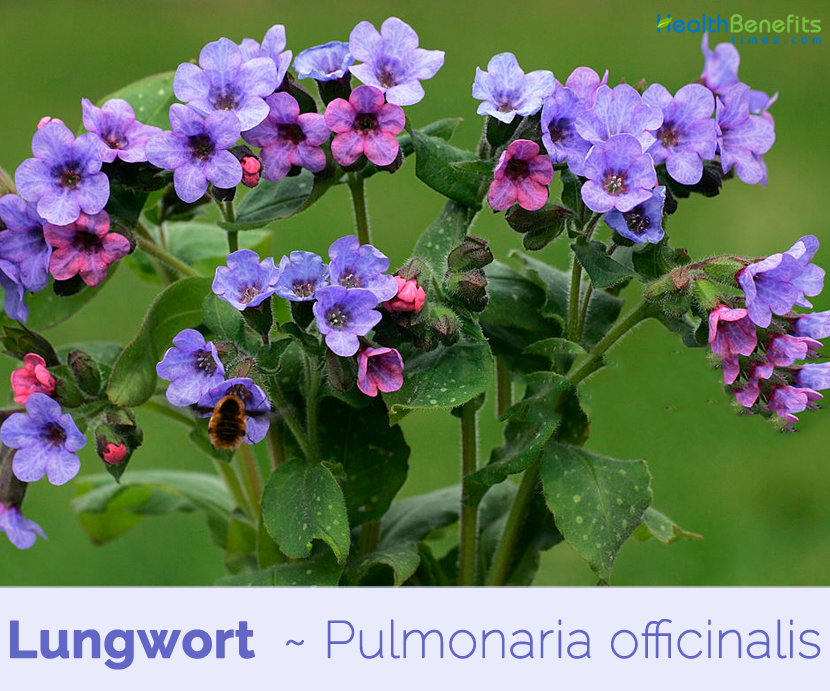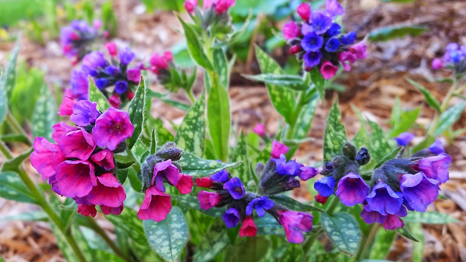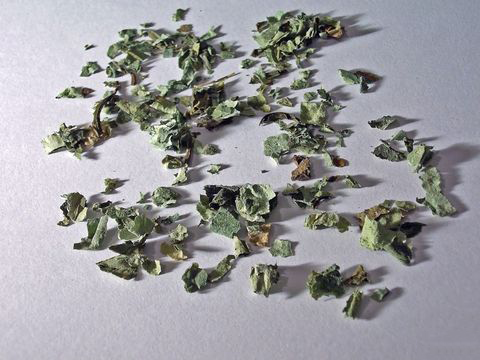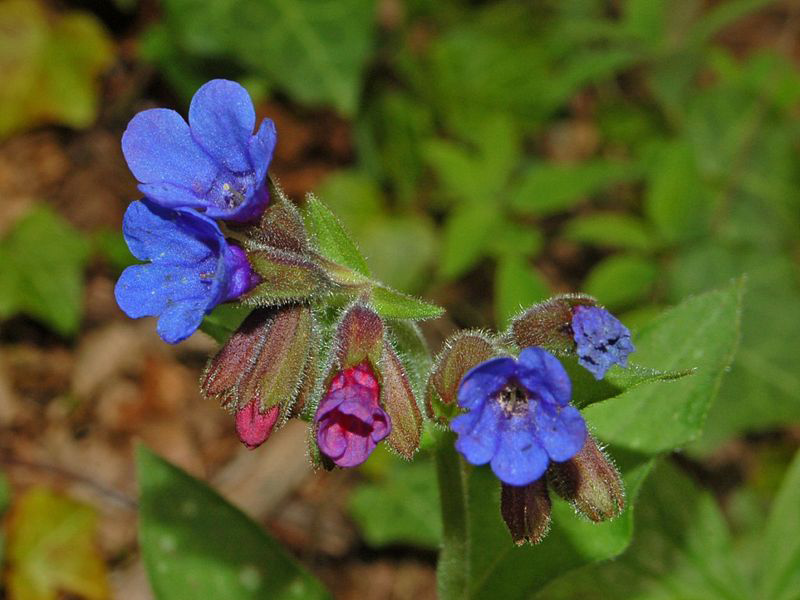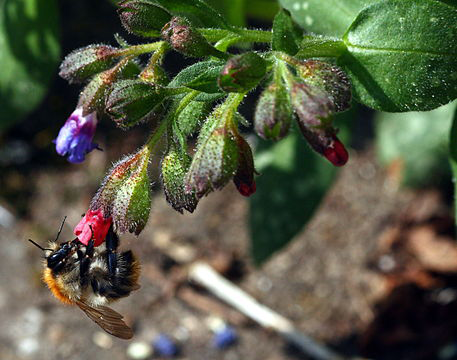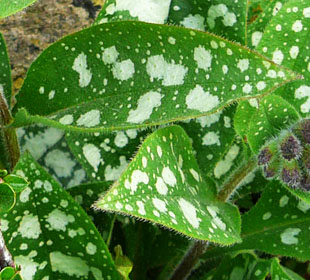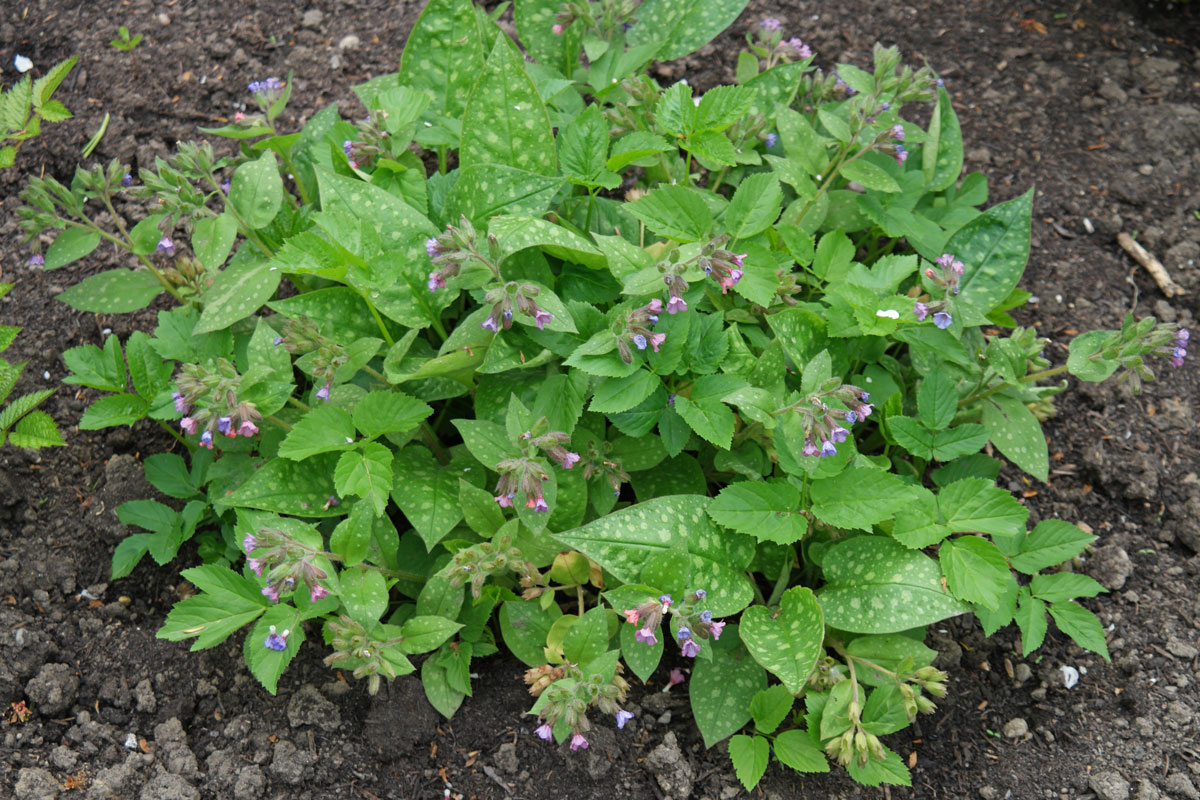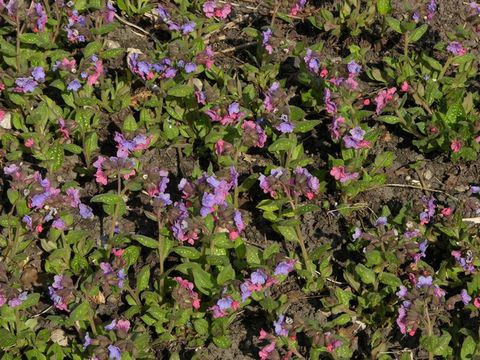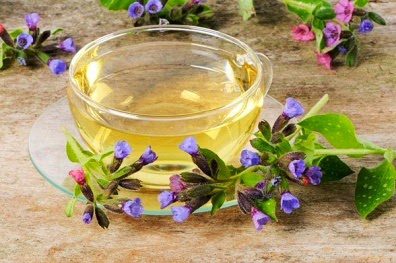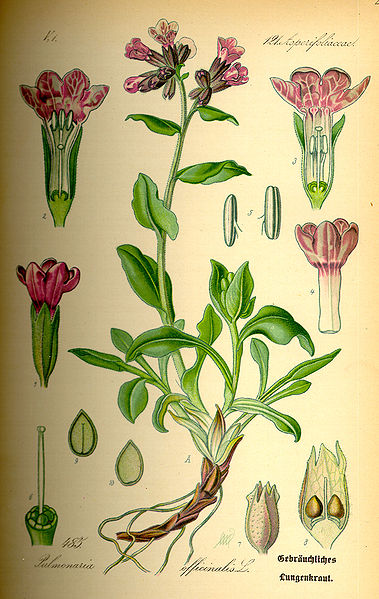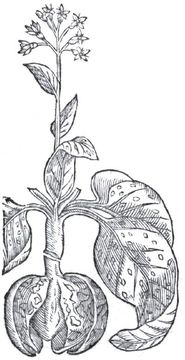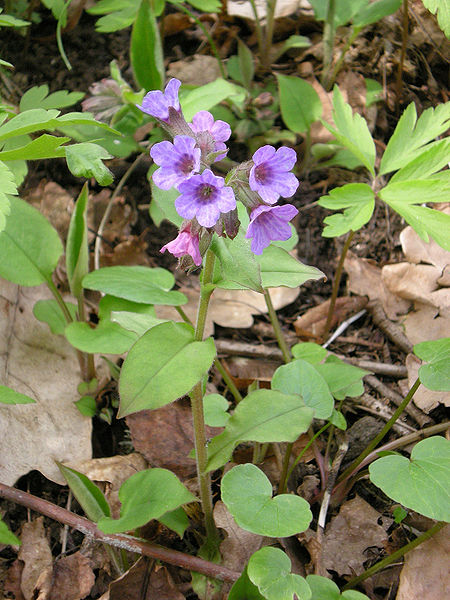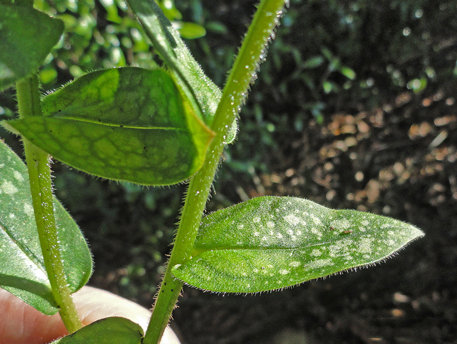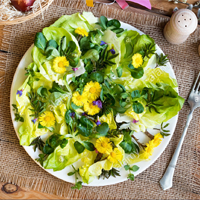Lungwort is also known as “Soldiers and Sailors”, because it changes the color of the flowers from red to blue. Two-colored flowers can be seen at the same time, like the colors of the uniforms of British army (red) and navy (blue). The genus name of Lungwort was given by the German physician Leonhart Fuchs who is also considered the founding father of botany. Genus name comes from the Latin pulmo meaning lung. In accordance with the Doctrine of Signatures, genus plants were once believed by medieval herbalists to be an effective remedy for treating lung diseases because the spotted plant leaves supposedly resembled diseased lungs. It is, however, well established today that there is no valid basis for believing genus plants have any value as medicinal plants. Specific epithet means sold in shops.
It is a natural plant that has been used around the world for a variety of respiratory ailments, including coughs, colds, bronchial detoxification and catarrhal problems. Because it’s very sensitive to environmental toxins, the areas in which it is found are typically unpolluted old forests, and thus, the presence of lungwort is often a good indicator of an ecosystem’s health.
Plant Description
Lungwort is an herbaceous evergreen or semi-evergreen, perennial rhizomatous plant that grows about one feet or 30 cm tall and 30cm wide. The plant is found growing in damp open woodland, including oak, hornbeam, lime, sycamore and beech woods, and is also found scrub land. The plant prefers fresh and shady areas, nutrient-rich and mostly calcareous, stony or pure clay loam soils. The plant has upright, unbranched, hairy stem that can reach 12 inches in height. Stems are covered in downy hairs. Basal leaves are green, cordate, more or less elongated and pointed and always with rounded and often sharply defined white or pale green patches. Leaves are covered with whitish-grey spots in the most species of lungwort and are quite hairy. Plant produces small bunches of flowers. Funnel-shaped 5-petals flowers are ¾ inches long and are red or pink at first, later turn to blue-purple during the anthesis, by changing the pH value inside of the petals. As a matter of fact the flowers contain a dye that belongs to the anthocyanins and change the color from red to blue. The flower can be white, red, blue and purple. Different colored flowers may be seen on the plant at the same time. Flowering normally takes place from March through May.
Health benefits of Lungwort
Lungwort is a traditional herbal remedy with a wide range of possible health benefits. It is mostly used to treat respiratory disorders such as coughing, bronchitis, and asthma. While there is few scientific proof of its effectiveness, it has been used for several years and anecdotal evidence as well as analysis of its chemical constituents recommends it has a role to play. Listed below are few of the popular health benefits of using lungwort
1. Reducing Irritation
The University of North Carolina classifies lungwort as a plant helpful for reducing irritation and providing soothing qualities. It is supposed that these beneficial properties, based mainly on irresistible anecdotal support, are thought as a respiratory aid.(1)
2. Respiratory Issues
Lungwort’s high mucilage content is known to be useful in respiratory conditions, namely asthma and, in particular, chronic bronchitis. While there isn’t a ton of research currently available, it is widely accepted that lungwort can be used by people with these conditions–in conjunction with doctor recommendations–as a complementary approach.
In traditional medicine, Lungwort was used to treat lung diseases such as cough, grippe, catarrh, hoarseness, cold, asthma and even tuberculosis. It is said that the herb has anti-biotic effect against chest infections. Some also believe that Lungwort can be used internally for treating bleeding of the lungs. (2)
3. For Better Digestion
Digestive health is of supreme importance to your overall health and well-being. Many people suffer from digestive troubles such as bloating, constipation, stomach pain and dyspepsia but there are sufficiently of good, effective remedies to be found in nature.
Drinking a soothing cup of lungwort tea can also help relieve a number of digestive and gastrointestinal problems including indigestion and diarrhea. Lungwort has mild diuretic properties which may help relieve the discomfort of bloating from excess water build-up while its astringent properties may also be responsible for treating attacks of diarrhea.
4. Beneficial for Skin
As we all know that lungwort is a rich source of natural antioxidants, it can play a very important role in helping your skin remain stronger and younger but that is not all. Lungwort can also be applied topically to the skin to help treat minor wounds and cuts. It consists of a chemical compound called allantoin that is known for its ability to heal tissue damage and expedite wound healing.
Lungwort can also be applied to the skin topically. Lungwort is effective when applied to the skin because of its astringent and anti-inflammatory nature. It can be applied to the skin to treat a whole range of skin conditions including burns, ulcers, hemorrhoids, and eczema.
5. Urinary Tract Infections
Although we are lacking in any fixed scientific evidence, lungwort has been used traditionally to treat infections of the urinary tract like cystitis. Because of its natural diuretic ability, it has also been used to treat kidney complaints. Diuretics or water pills are often recommended for urinary tract conditions because they help promote the production of fluids in the body and increase the frequency of urination. This can help expel toxins and relieve infection but prescription diuretics also bring a risk of adverse side effects.
https://www.youtube.com/watch?v=KuU60LhjOgA
Traditional uses and benefits of Lungwort
- Plant is useful in the treatment of chest diseases and asthma.
- Lungwort has high mucilage content and this makes it useful in the treatment of chest conditions, being of particular benefit in cases of chronic bronchitis.
- It combines well with other herbs such as coltsfoot in the treatment of chronic coughs including whooping cough and can also be taken to treat asthma.
- Leaves and flowering shoots are astringent, demulcent, diaphoretic, diuretic, emollient, mildly expectorant and resolvent.
- They are often used for their healing effect in pulmonary complaints and their mucilaginous nature makes them helpful in treating sore throats.
- Leaves can also be used externally to stop bleeding.
- Distilled water made from the plant is effective eyewash for tired eyes.
- Homeopathic remedy is made from the plant.
- It is used in the treatment of bronchitis, coughs and diarrhea.
- Leaves have been supposed to be demulcent and pectoral, and have been used in coughs and lung catarrhs in the form of an infusion.
- It is beneficial for lungs and helps to clear the airways and expels the mucus from the lungs.
- It has anti-inflammatory and antibacterial properties that prevent viral or bacterial infection in the lungs.
- It is usually used in the form of a tea but can also be used topically on the skin to treat wounds and for overall skin care purposes.
- Lungwort Tea may help in the treatment of such lung diseases as tuberculosis, asthma, and coughs.
- Lungwort Tea may be helpful against bronchial disorders and sore throat.
- Lungwort Tea may help against bacteria responsible for chest infections.
- Lungwort Tea may help in the treatment of gastrointestinal and kidney problems.
- Lungwort Tea or tincture, when applied externally, may be used to treat eczema, hemorrhoids, wounds and burns.
- Some herbalists prescribe lungwort to control diarrhea.
- Chesty coughs, wheezing, and shortness of breath were thought to benefit from an infusion of the dried leaves.
- Distilled water prepared from this herb is known to be effectual eyewash for healing tired eyes.
- Homeopathic medication prepared from the plant is used to cure coughs, bronchitis as well as diarrhea.
Ayurvedic Health benefits of Lungwort
- Lungs: Take 4 to 5 fresh lungwort leaves. Boil it in a glass of water for 10 minutes. Cool it and strain and drink this tea twice a day.
- Pulmonary Fibrosis: Boil a few fresh leaves of lungwort. Strain and drink this tea 2 times in a day. OR Take tincture (10 drops 2 times in a day.)
Culinary Uses
- Leaves can be consumed raw or cooked.
- They can be added to salads or used as a potherb.
- Leaves are low in fiber and make an acceptable addition to mixed salads, though their mucilaginous and slightly hairy texture makes them less acceptable when eaten on their own.
- Young leaves make a palatable cooked vegetable though we have found the texture to be somewhat slimy.
Dosages
Aerial parts of the lungwort plant are used to prepare oral and topical formulations. The preparations are available as infusions, dried leaves, and fluid extract.
The usual oral and topical doses are:
- Dried leaves: 2 g to 4 g, 3 times per day
- Infusion: 2 g to 4 g dried leaf, 3 times per day
- Fluid extract: 2 g to 4 g dried equivalent, 3 times per day
The topical formulations should be applied to affected area(s) only.
Other Facts
- It is a tolerant and slow growing ground cover plant for open woodland and border edges.
- Lungwort is important food source for larvae of certain insects and moths.
Precautions
- Avoid use during Pregnancy and breast feeding.
- Excess use may cause menstrual disorders, upset stomach and skin Inflammation.
- Lungwort might cause a rash in some sensitive people.
- This herb and tea are also not recommended for long-term use.
Recipes
Egg salad with lungwort
Ingredients
- ½ cup lungwort leaves, washed and finely shredded
- 2 hard-boiled eggs, sliced into rings
- 1 small lettuce (i.e. little gem), shredded
- ½ cup mixed salad leaves
- 2 spring onions, thinly sliced
- 2 Tbsp. mayonnaise
- salt and freshly-ground black pepper, to taste
Direction
- Arrange the lettuce on the base of a serving dish and top with the sliced eggs.
- Top the eggs with the mixed salad leaves.
- Mix together the spring onions, mayonnaise, lungwort leaves and seasonings in a bowl. Use this to top the salad and serve immediately.
Lungwort Leaf Gumbo
Ingredients
- ½ cup butter
- 4 celery sticks, chopped
- 1 small onion, finely chopped
- 2 parsley sprigs, finely chopped
- 1/2 green bell pepper, finely chopped
- 3 garlic cloves, finely chopped
- ½ cup flour
- 4 Tbsp lungwort leaf powder
- 8 ½ cups fish stock or water
- 2 bay leaves
- 1 sprig of thyme
- 1 chili pepper, finely chopped
- ¼ pound smoked ham, diced
- ¼ pound hot sausage (chorizo is good) cut into ½ inch slices
- 1/3 pound prawns, shelled (reserve shells and heads for stock)
- ½ pound firm white fish, cubed
- salt and black pepper, to taste
Directions
- Place the butter in a large soup pan and heat to melt.
- When nicely melted and sizzling add the celery, onion, parsley, bell pepper and garlic.
- Fry over a low flame for about 20 minutes, or until the onion is soft and golden then add the flour and lungwort leaf powder.
- Stir the mixture constantly for about ten minutes to form a roux then add the stock and bay leaves.
- Bring to a simmer then cook for about 20 minutes before adding the ham, fish and sausage.
- Continue cooking for a further 30 minutes.
- Bring to a boil, stirring constantly then add the prawns and thyme.
- Continue cooking for about 2 minutes then adjust the seasonings and serve on a bed of rice.
References:
http://www.theplantlist.org/tpl1.1/record/kew-2413004
https://www.itis.gov/servlet/SingleRpt/SingleRpt?search_topic=TSN&search_value=507139#null
https://davesgarden.com/guides/pf/go/177256/
https://pfaf.org/user/plant.aspx?latinname=Pulmonaria+officinalis
https://www.botanical.com/botanical/mgmh/l/lungwo49.html
https://plants.usda.gov/core/profile?symbol=PUOF
https://en.wikipedia.org/wiki/Pulmonaria_officinalis
Comments
| Lungwort Quick Facts | |
|---|---|
| Name: | Lungwort |
| Scientific Name: | Pulmonaria officinalis |
| Origin | Damp habitats and coastal areas in Europe, Asia, North America, and Africa |
| Taste | Mucilaginous and bitter taste |
| Health benefits | Reducing Irritation, Respiratory Issues, For Better Digestion, Beneficial for Skin, Urinary Tract Infections |
| Name | Lungwort |
|---|---|
| Scientific Name | Pulmonaria officinalis |
| Native | Damp habitats and coastal areas in Europe, Asia, North America, and Africa |
| Common Names | Lungwort, Common lungwort, Jerusalem Sage, Jerusalem Cowslip, Sage of Jerusalem, Pulmonaire, Sauge de Bethlehem, Coucou Bleu Lungenkraut, Spotted Dog, Soldiers and Sailors, Joseph and Mary, Bethlehem Sage, Our Lady’s Milk Drops, Spotted Lungwort, Oak Lungs, Herbe aux Poumons, Pulmonariae Herba, lung moss, spotted comfrey, Adam and Eve, Bedlam cowslip, Beggar’s basket, Bugloss cowslip, Lady’s cowslip, Lady’s milk, Mary’s honeysuckle, Mary’s tears, Virgin Mary’s honeysuckle |
| Name in Other Languages | Danish: Hvidplettet lungeurt Dutch: Gevlekt longkruid English: Jerusalem cowslip, Jerusalem-sage, Joseph-and-Mary, Mary-spilt-the-milk, Bloody-butcher, Boys-and-girls, Common lungwort, Hundreds-and-thousands, Lungwort, Soldiers-and sailors, Spotted-dog, Blue lungwort, Finnish: Rohtoimikkä French: Pulmonaire officinale German: Echtes Lungenkraut, Geflecktes Lungenkraut, Gemeines Lungenkraut, Kleingeflecktes Lungenkraut, Blauer Himmelschlüssel, Blaues Himmelschlüsselchen, Himmelschlüssel Nynorsk, Norwegian: Lungeurt Romanian: cuscrisor, mierea ursului Swedish: Fläcklungört, lungört |
| Plant Growth Habit | Herbaceous evergreen or semi-evergreen, perennial rhizomatous plant |
| Growing Climates | Grows in damp open woodland, including oak, hornbeam, lime, sycamore and beech woods, and is also found scrub |
| Soil | Prefers fresh and shady areas, nutrient-rich and mostly calcareous, stony or pure clay loam soils |
| Plant Size | About one feet or 30 cm tall and 30cm wide |
| Stem | Upright, unbranched, hairy stem that can reach 12 inches in height. Stems are covered in downy hairs |
| Leaf | Basal leaves are green, cordate, more or less elongated and pointed and always with rounded and often sharply defined white or pale green patches. Leaves are covered with whitish-grey spots in the most species of lungwort and is quite hairy |
| Flowering Period | March through May |
| Flower | Plant produces small bunches of flowers. The 5-petals flowers are red or pink at first, later turn to blue-purple during the anthesis, by changing the pH value inside of the petals. |
| Flavor/Aroma | Do not have any peculiar aroma |
| Taste | Mucilaginous and bitter taste |
| Plant Parts Used | Leaves |
| Available Forms | Fresh leaves, dried leaves, powder, tinctures, syrup, tea, capsules |
| Season | May to June |
| Propagation | By seeds |
| Health benefits |
|


